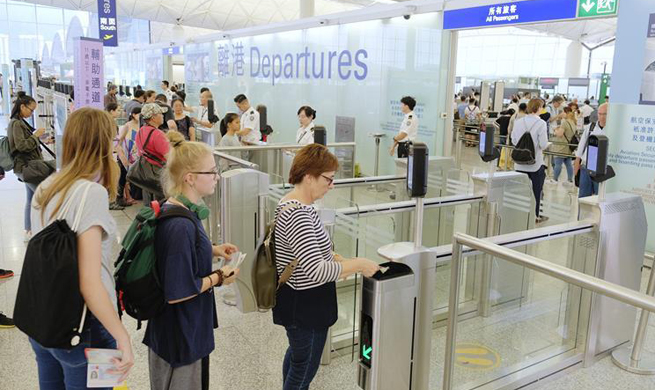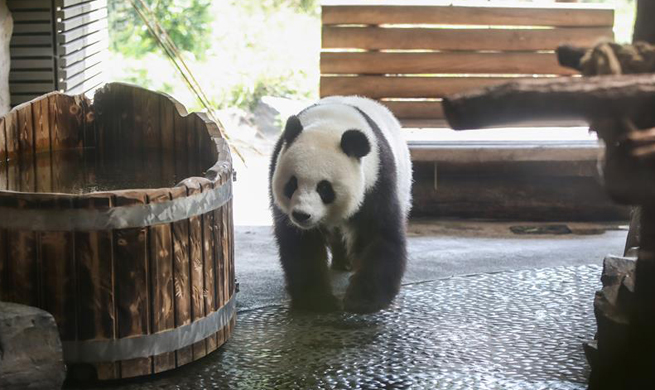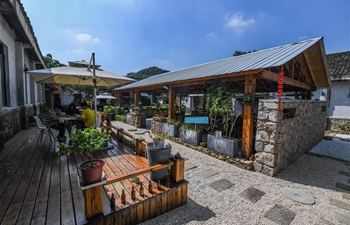ANKARA, Aug. 14 (Xinhua) -- Turkish drones started operating in northern Syria on Wednesday as part of a recent agreement between Turkey and the United States on the creation of a safe zone there.
Turkish Defense Ministry said in a statement that drones started carrying out work in the area where the safe zone, or "peace corridor," for the return of refugees will be created, but the statement did not provide further information on the drones' operations.
Efforts were underway to set up a Joint Operations Center in the southeastern Turkish province of Sanliurfa operational "as soon as possible," it added.
A U.S. delegation arrived in Sanliurfa on Monday to set up the center that will oversee the establishment of the safe zone.
The move followed an agreement that were concluded after intense talks in the Turkish capital of Ankara on Aug. 7 between U.S. and Turkish officials to address Turkey's long-standing security concerns along its southern border.
Although details of the safe zone's size and management remain undetermined, the command center is expected to be a pillar of negotiations shaping the future of a region that has been a severe friction point in U.S.-Turkey relations.
Washington and Ankara, two NATO allies, have been at odds for a long time over plans for northeastern Syria, where U.S. allies are fighting the battle against the Islamic State (IS) militants.
However, Turkey sees the U.S.-backed Kurdish People's Protection Units (YPG) as an extension of the Kurdistan Workers' Party (PKK) which is designated as a terrorist organization by Turkey, the United States and the European Union.
Even though an agreement has been reached between the two allies, divisions remain on the role, implementation and functioning of the future buffer zone, according to observers.
Some analysts view the establishment of the Joint Operations Center as a U.S. mechanism to buy time and delay potential Turkish new military incursion into Syria.
"Details of the Turkish-U.S. deal have not been announced and we know nothing on the depth of the planned safe zone. Turkey wants a buffer zone up to 30-40 km deep inside Syria while the Americans are not keen on a zone more than five km deep, so for the moment there are many uncertainties," said Naim Baburoglu, a military analyst, on private broadcaster NTV.
"Turkey should not let the United States buy time and try to prevent a Turkish incursion in northeastern Syria, east of the Euphrates, by engaging in interminable negotiations" about the parameters of a safe zone, said the retired Turkish army general.
Baburoglu recalled that during the first Gulf war in 1991, the United States implemented a safe zone and a no-fly zone in northern Iraq that led to strengthening of the PKK which established camps there which are still a threat to Turkey.
According to information regarding the safe zone published in the Turkish media, the United States wants to confine the presence of Turkish troops to rural areas only, and holds full command of all areas except a five-km-strip at the border that would be under Turkish control.
Ankara sees the Kurdish identity as threat not only inside Turkey but also in northern Iraq and in northern Syria, fearing that Kurds there might establish an autonomous state.
According to the pro-government press, military option against the YPG is still very much on the table in Ankara.
"Turkey won't allow the U.S. to stall the process for the operation east of the Euphrates like they did in Manbij," a town in northeastern Syria where Turks and Americans established a joint patrol protocol after months of U.S. stalling, Turkish Foreign Minister Mevlut Cavusoglu told reporters at the weekend.
If the United States hesitate to meet Ankara's demands over the safe zone which include a corridor 32 km deep into Syrian territory, Turkey could pursue its own solutions in the region where up to 2,000 U.S. troops are deployed, Turkish Defense Minister Hulusi Akar warned on Monday.
The buffer zone agreed between Ankara and Washington would also allow Syrian refugees to return to their homelands in the country's north.
Turkey is current hosting the world's biggest refugee community with 3.6 million Syrians, but since the onset of the economic crisis last summer which triggered high unemployment, resentment has been growing against the migrants.

















